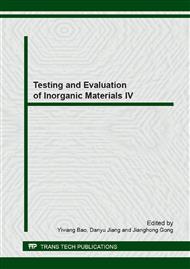p.272
p.277
p.281
p.285
p.289
p.293
p.297
p.301
p.305
Test of Relative Translucency of 5 All-Ceramic Core Materials
Abstract:
Objective:To study the relative translucency of 5 veneered and glazed all-ceramic systems core material, including Procerra AllCeram Alumina, Vita In-Ceram Zirconium, Ivoclar Vivodent Empress, In-Ceram Spinell and Colored Zirconia. Methods: Under standard black and white background, the surface light reflectivity of 5 veneered all-ceramic systems core material was determined with contact color difference meter, and the ratio of Yb /Yw was calculated. Results: After veneered, the relative translucency of 5 core materials all declined, and ranged from 0.6740 of In-Ceram Spinell to 1.00 of In-Ceram zirconia, among of that In-Ceram Spinell was most transparent. Conclusion: Among the groups, there is no significant differences among Empress II, Procera AllCeram and Colored Zirconia (IL1,IL2,IL3). Compared with Procera AllCeram and Vita In-Ceram Zirconium , Procera AllCeram has significant difference. There is a significant difference between Procera AllCeram and In-Ceram Spinell.
Info:
Periodical:
Pages:
289-292
Citation:
Online since:
November 2013
Authors:
Keywords:
Price:
Сopyright:
© 2014 Trans Tech Publications Ltd. All Rights Reserved
Share:
Citation:


